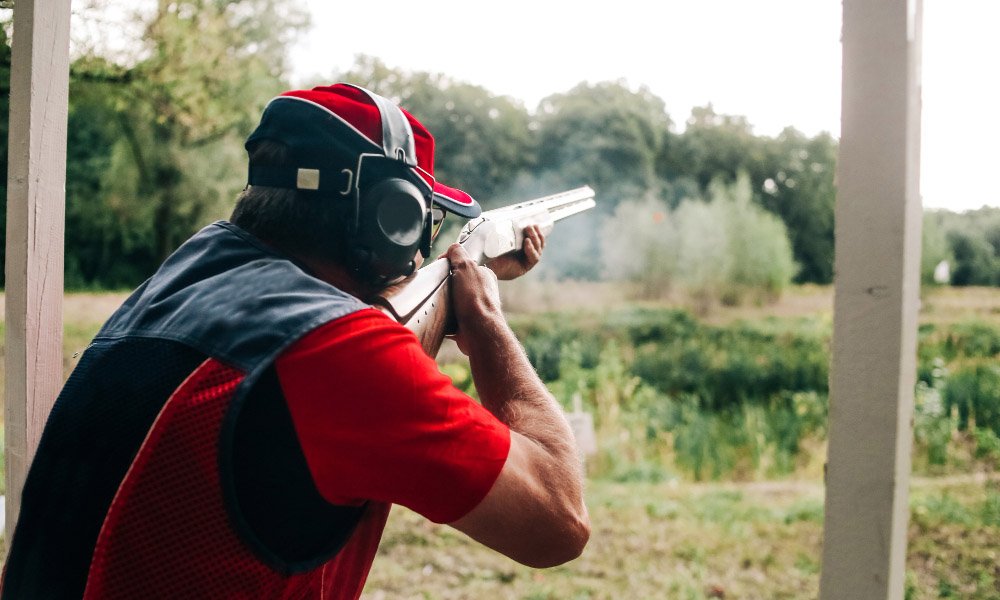Guide
The Hidden Factors That Affect Accuracy on the Shooting Range
Published
2 days agoon
By
Alexander
Most shooters blame their misses on bad technique or insufficient practice time. While both matter, plenty of experienced shooters struggle with accuracy issues that have nothing to do with trigger control or stance. The reality is that several less obvious factors can sabotage performance at the range, and most people never realize what’s actually causing their inconsistency.
Gun Fit Matters More Than Most People Think
Here’s something that catches shooters off guard: expensive equipment won’t shoot straight if it doesn’t fit properly. The relationship between a shooter’s body and their firearm determines how naturally the sights align when bringing the gun to position. When the fit is wrong, compensation becomes necessary, and compensation creates inconsistency.
Length of pull affects everything. Too long, and the shooter has to reach forward, creating tension in the shoulders and making it harder to maintain proper head position. Too short, and the recoil drives back into the face rather than the shoulder pocket. Either situation forces the body into awkward positions that change slightly from shot to shot.
Drop at comb height presents another common issue. If the comb sits too high, the shooter’s cheek pressure pushes the head up and back, resulting in high shots. Too low, and the shooter has to crane their neck down to see properly, which creates muscle tension and inconsistent cheek weld. Break action designs make proper fit even more important, which is why many experienced shooters prefer an over under shotgun since the consistent sight plane helps identify fit issues that need correction rather than masking them.
Cast—the lateral offset of the stock from the barrel centerline—gets ignored by most shooters until someone points out that their groups consistently drift to one side. Right-handed shooters with cast issues often shoot left because the stock pushes their face off-center, and they end up looking across the rib instead of straight down it.
Environmental Conditions Create Real Problems
Temperature swings affect more than comfort levels. Powder burns differently in cold weather, which changes velocity and therefore point of impact. A load that shoots dead-on at 70 degrees might hit two inches low at 30 degrees. Most shooters never make this connection because they zero their sights in one season and assume the settings remain valid year-round.
Wind poses the obvious challenge, but mirage presents a sneakier problem. On hot days, heat waves rising from the ground or barrel distort the target image through the sights. Shooters see what looks like target movement and make corrections for something that isn’t actually happening. The target hasn’t moved—the air between the shooter and target is just messing with perception.
Lighting angle changes everything about sight picture. Morning light coming from behind creates one sight picture, while afternoon light from the side creates another. Shadows fall differently on front and rear sights depending on sun position, which means the alignment that looked perfect at 9 AM might not be the same alignment at 3 PM. Indoor ranges with consistent overhead lighting eliminate this variable, which is why some shooters perform better indoors than out.
Physical Factors That Nobody Talks About
Caffeine intake before shooting creates problems that most people attribute to nerves. Coffee doesn’t just wake people up—it increases heart rate and creates a slight tremor in the hands. That tremor might not be visible, but it’s enough to add movement to the sight picture right when the trigger breaks. The shooter who stops for coffee on the way to the range might be sabotaging their first hour of shooting without realizing it.
Dehydration affects fine motor control before thirst becomes noticeable. Studies show that even mild dehydration reduces reaction time and precision in movements. At the range, this translates to inconsistent trigger press and less stable hold. The shooter who skips water because they don’t feel thirsty might be operating at reduced capacity.
Eye dominance issues create accuracy problems that get blamed on everything else. Cross-dominance—where the dominant eye doesn’t match the dominant hand—means the brain receives conflicting information about where the barrel is actually pointing. Some shooters compensate instinctively, but others fight this their entire shooting career without understanding why they struggle more than their training partners.
Vision fatigue sets in after extended range sessions. The eyes work hard to maintain focus on front sight, rear sight, and target, constantly shifting between different focal planes. After an hour or two, this focus starts to deteriorate, but most shooters just keep shooting through it. Groups that started tight in the first hour open up in the third hour, and the shooter assumes they’re getting tired or losing concentration when really their eyes just need a break.
Equipment Variables Beyond the Basics
Ammunition consistency within the same box matters more than most realize. Even quality ammunition shows velocity variations from round to round. A 50 feet-per-second difference in velocity translates to point of impact changes at distance. Shooters often blame themselves for flyers when the round itself was the problem.
Barrel heat affects accuracy in ways that surprise people. As barrels heat up during shooting sessions, the metal expands unevenly, which can shift point of impact. Some barrels walk their groups upward as they heat, others drift horizontally. Letting the barrel cool between strings produces different results than rapid fire, but most shooters never test this variable to see how their specific equipment behaves.
Magazine and ammunition interaction creates reliability issues that hurt accuracy. Rounds that don’t feed perfectly from the magazine can enter the chamber at slightly different angles, affecting how they seat. This inconsistent chambering shows up as vertical stringing on target. The shooter assumes they’re jerking the trigger when the real problem is mechanical.
The Mental Game That Gets Ignored
Expectation affects performance more than technique does in many situations. Shooters who expect to miss often do, not because of poor fundamentals but because they subconsciously change their follow-through. The brain sees the anticipated miss and starts preparing for the next shot before the current shot breaks. This anticipation creates a slight flinch that becomes self-fulfilling.
Target fixation pulls shots off mark in predictable ways. When shooters stare at where they don’t want to hit—the edge of the target, the boundary line, an obstacle—they tend to hit exactly that spot. The brain processes “don’t hit that” as “focus on that,” and the body follows what the mind emphasizes.
Making Real Improvements
Identifying which factors affect accuracy requires systematic testing rather than guessing. Shooting the same ammunition at the same target from the same position eliminates variables and reveals patterns. If groups shift based on time of day, lighting is the problem. If the first shots after cleaning land differently than subsequent shots, barrel fouling matters for that specific setup.
The shooters who improve fastest are the ones who treat accuracy problems as puzzles to solve rather than personal failures. Equipment, environment, and physical state all contribute to where rounds land. Fixing accuracy issues means identifying which variables are actually causing the problem instead of just practicing more and hoping for improvement.
Most range time gets spent shooting rather than diagnosing. Taking the time to test different positions, lighting conditions, and equipment configurations reveals more about accuracy limitations than another hundred rounds through the same setup. The hidden factors stay hidden until someone specifically looks for them.
You may like


Defensive Driving Course New Jersey

Smart Policies for Google Drive File Management: Retention, Labels & Automation

5 Best Sites to Buy Google Reviews Of 2025 (Real & Non- Drop)

Choosing the Perfect Ballet Shoes: A Guide for Young Dancers

Essential Guide to Molicare Pads: Comfort and Care Solutions

Unlocking Radiant Skin: The Benefits of LED Light Therapy

Building a Successful Cannabis Grow: Where Most People Start Wrong

How Cosmetic Dentistry Transforms Lives

Top 5 Best Advertising Agencies in UAE for Effective Brand Promotion

Improving Connection in the Workplace

Carol Kirkwood’s Journey: Her Real Age, Husband, Career, and More

Revolutionizing Healthcare: The Emergence of AI-Driven Analytics

How Machine Learning and AI are Redefining the Future?

Aliza Barber: Meet Lance Barber’s Wife, Age, Life, Profile, Career and Net Worth

Evelyn Melendez: Jordan Knight’s Wife Bio, Marriage, Family, Career and Net Worth

Ilan Tobianah Biography: Family, Marriage, Lifestyle, Career and Net Worth

Who was Alice Marrow? Everything to Know About Ice-T’s and His Mother

King Von’s Autopsy Report: The Truth Behind the Tragic Death

Meet Otelia Cox: The Supportive Wife of Tony Cox – A True Fairy Tale Romance

Tea Leoni and Tim Daly Split – A Closer Look at Their Relationship and Breakup

Defensive Driving Course New Jersey

Smart Policies for Google Drive File Management: Retention, Labels & Automation

5 Best Sites to Buy Google Reviews Of 2025 (Real & Non- Drop)

Choosing the Perfect Ballet Shoes: A Guide for Young Dancers

Essential Guide to Molicare Pads: Comfort and Care Solutions

Unlocking Radiant Skin: The Benefits of LED Light Therapy

Building a Successful Cannabis Grow: Where Most People Start Wrong

How Cosmetic Dentistry Transforms Lives

Top 5 Best Advertising Agencies in UAE for Effective Brand Promotion

Improving Connection in the Workplace
Category
Trending
-

 News2 months ago
News2 months agoCarol Kirkwood’s Journey: Her Real Age, Husband, Career, and More
-

 Health2 years ago
Health2 years agoRevolutionizing Healthcare: The Emergence of AI-Driven Analytics
-

 Technology2 years ago
Technology2 years agoHow Machine Learning and AI are Redefining the Future?
-

 Celebrity2 years ago
Celebrity2 years agoAliza Barber: Meet Lance Barber’s Wife, Age, Life, Profile, Career and Net Worth
